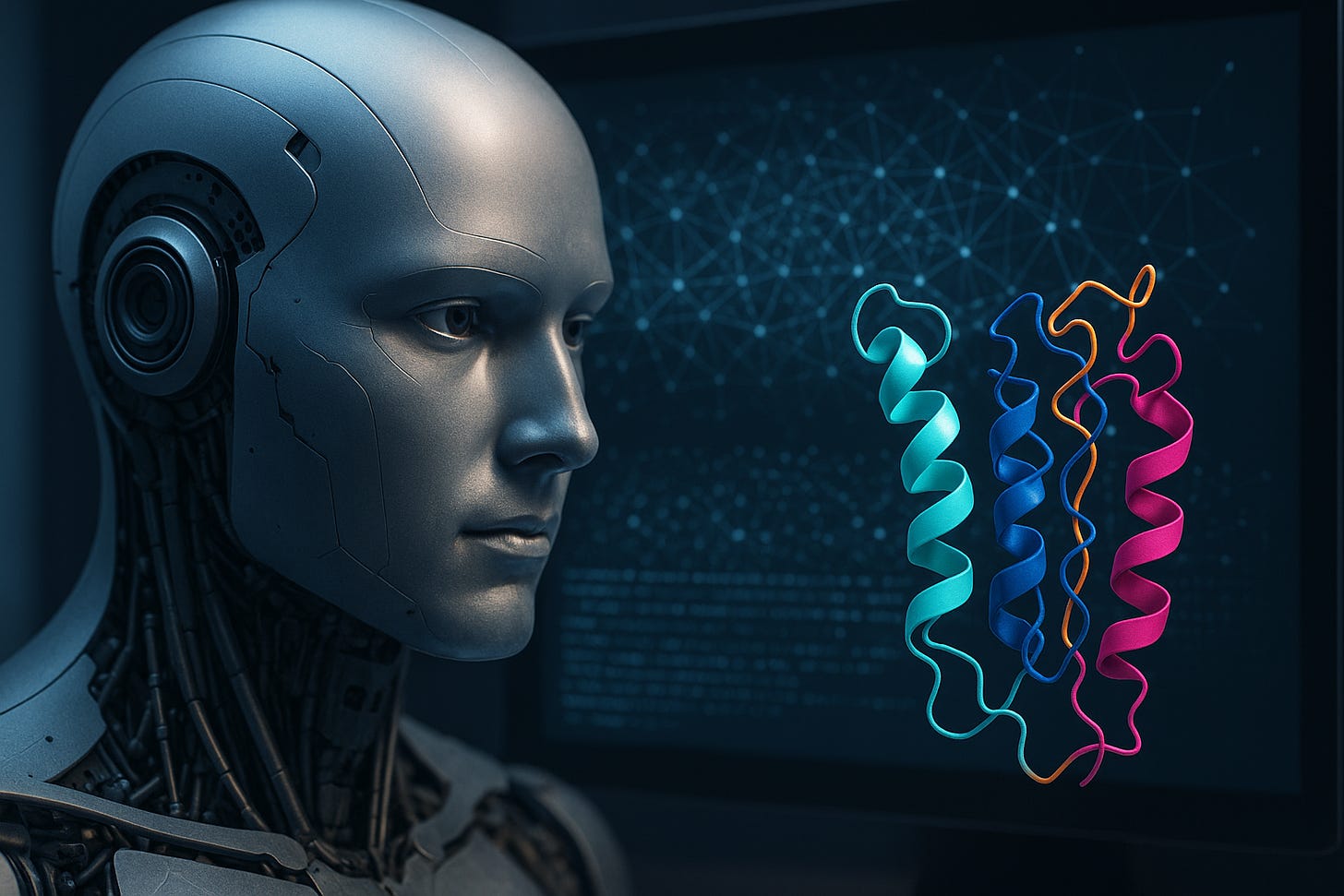The news came out in late August, wrapped in the technical language of a research announcement: OpenAI and Retro Biosciences had used a new AI model—GPT-4b micro—to design better transcription factors for cell reprogramming. For most people, it read like another advance in a long list of AI-assisted discoveries. But inside the world of biology, this was something else entirely. It was a sign that the future of scientific discovery may not be driven by monolithic generalist AIs but by specialized cousins tuned for precision, depth, and impact.
The result—a fifty-fold improvement in the efficiency of stem cell reprogramming markers—wasn’t just a marginal gain. It was a leap across the kind of bottleneck that has frustrated regenerative biology for decades. And the way it happened may tell us as much about the future of AI as it does about the future of medicine.
The podcast audio was AI-generated using Google’s NotebookLM.
SPECIAL: This week, the TCIP podcast crossed the 30,000 downloads mark. A huge thank you to you for your time to read, listen, and discuss these topics.
From giants to instruments
Over the last few years, the story of AI has been a story of scale. The bigger the model, the better the performance. GPT-3 stunned the world in 2020 with 175 billion parameters. GPT-4o pushed even further, with multimodal reasoning across text, vision, and audio. In AI circles, scale became the shorthand for progress.
But science isn’t about scale. Science is about specificity. It’s about the details of a protein fold, the timing of a gene’s expression, the quirks of a single cell line. Throwing a trillion-parameter model at biology might produce some interesting hypotheses, but it won’t replace the hard work of generating proteins that actually fold, bind, and function in the wet lab.
This is where GPT-4b micro comes in. Instead of asking a generalist to learn a new field on the fly, OpenAI and Retro Bio created a scaled-down, domain-tuned sibling. It wasn’t trained on the entire internet; it was trained on protein sequences, 3D structural motifs, and biological text. It wasn’t asked to be a universal chatbot; it was built as a protein engineer.
The results were immediate and profound. Where traditional directed-evolution methods explore only tiny slices of the protein design space, GPT-4b micro proposed hundreds of radically different sequences—variants that differed by more than a hundred amino acids from the original proteins, yet still folded and functioned in the right way. In some screens, over 30% of its suggestions outperformed wild-type proteins, compared to hit rates of less than 10% in traditional approaches.
This is not a matter of “bigger is better.” It’s a matter of tuned is transformative.
The Yamanaka factor problem
To understand why this matters, you need to know the backstory. In 2006, Shinya Yamanaka discovered that just four proteins—OCT4, SOX2, KLF4, and MYC—could reprogram adult fibroblasts into pluripotent stem cells. The simplicity of the recipe stunned biologists. Four ingredients to roll back the clock of cell identity.
The discovery won Yamanaka a Nobel Prize in 2012. But for all its elegance, the cocktail had a crippling flaw: efficiency. In many experiments, fewer than 0.1% of cells actually converted. The process could take weeks. And with older or diseased donor cells, success rates dropped even further.
For two decades, labs around the world tried to improve on this. Directed-evolution campaigns, mutagenesis screens, and careful domain swapping. The progress was incremental at best. After fifteen years, the best engineered variants differed from natural SOX2 by just a handful of residues.
Then GPT-4b micro came along. Instead of tweaking a few amino acids, it rewrote the proteins wholesale. RetroSOX and RetroKLF weren’t subtle modifications; they were bold reimaginings. And they worked. In fibroblast screens, late pluripotency markers appeared days earlier than in cells reprogrammed with the original Yamanaka cocktail. In mesenchymal stromal cells from donors over fifty, more than 30% expressed stem cell markers within a week. The colonies that emerged were healthy, stable, and genomically intact.
This is what AI can do when it stops being a generalist and becomes a specialist. It doesn’t just accelerate discovery—it reshapes the problem space.
Why specialization matters
There’s a lesson here that extends far beyond biology. Generalist LLMs are astonishing at reasoning across domains, but their strength is breadth, not depth. They can draft essays, summarize papers, or suggest ideas. But when the problem is a protein with 317 amino acids and an astronomical number of possible variants, breadth is useless.
What scientists need is depth with context. That’s what GPT-4b micro offered: protein-centric embeddings enriched with co-evolutionary data, structural motifs, and functional annotations. The model could be prompted not just with a question but with a design goal: make this factor more efficient at reprogramming cells.
The broader implication is that science may evolve into a landscape of specialized AI instruments. A model for protein design. Another for metabolic pathway modeling. Another for materials science. Instead of a single AI oracle, we’ll have a suite of tuned instruments, each honed for a specific kind of discovery.
This doesn’t diminish the role of generalist models. It reframes them. Think of them as the operating system—the environment where scientific reasoning happens. The specialized siblings are the applications, the finely crafted tools that do the heavy lifting.
Universal cell plasticity: the next frontier
If AI can design better Yamanaka factors, what else can it do? The logical endpoint is tantalizing: generalized transcription factor cocktails capable of converting any cell type into any other.
This has been a dream of regenerative biology for decades. Every cell in your body carries the same genome; the difference between a neuron and a hepatocyte isn’t the DNA itself but the regulatory program that controls which genes are turned on or off. Reprogramming is essentially rewriting that regulatory code.
Until now, it’s been more art than science. Recipes are discovered piecemeal—this set of factors turns fibroblasts into neurons, that set turns them into cardiomyocytes. But there’s no universal codebook.
What if AI could generate one? What if, instead of trial and error, we had a Rosetta Stone of cell identity, a computational map of transcription factor space that could be used to design cocktails for any conversion?
The implications are staggering:
Medicine: damaged heart tissue after a heart attack could be rebuilt with cells reprogrammed directly in place.
Cancer: malignant cells might be pushed back into a normal state instead of being destroyed.
Aging: senescent cells could be rejuvenated at scale, restoring function across tissues.
Transplants: organ shortages could be addressed by building tissues from a patient’s own reprogrammed cells, eliminating rejection risk.
In short, a universal reprogramming toolkit could make biology as programmable as software.
The acceleration loop
One of the striking aspects of the OpenAI–Retro collaboration is speed. What took biologists fifteen years to achieve with careful experimentation—variants differing by a few residues—took GPT-4b micro less than a year to blow past, generating sequences with hundreds of changes that outperformed the originals.
This speed comes from a feedback loop between AI and the lab. The model proposes bold candidates, the lab tests them quickly, and the results feed back into the model. Each cycle compresses discovery timelines further. What once took years now takes weeks.
It’s not hard to see where this leads. With autonomous labs, cloud biology platforms, and continuous model retraining, the cycle could become nearly self-driving. Scientists might set the goals—make this factor more efficient, reprogram this cell type into that one—and the AI-lab loop does the rest.
That doesn’t mean scientists are out of the picture. It means their role shifts from trial-and-error experimentation to strategy, interpretation, and application. The discovery engine itself hums in the background, powered by specialized models and automated labs.
Guardrails and governance
Of course, the power to reprogram cells isn’t just scientific. It’s social, medical, and regulatory. If generalized transcription factor cocktails become real, the line between therapy and enhancement blurs. The risks of off-target effects, tumorigenesis, and misuse are non-trivial.
The OpenAI–Retro announcement was careful to note genomic stability, successful differentiation into germ layers, and replication across donors. But history teaches us that translation from lab to clinic is fraught. The road from iPSC discovery to approved therapies has been long precisely because of safety concerns.
As specialized models accelerate discovery, governance will have to accelerate alongside them. Not in a way that stifles innovation, but in a way that ensures therapies are safe, accessible, and equitably distributed. Otherwise, the promise of programmable biology risks being captured by a handful of institutions, leaving society unprepared for its consequences.
The horizon
It’s tempting to dismiss the idea of universal cell reprogramming as futuristic speculation. But remember: fifteen years ago, the idea that four proteins could reset cell identity sounded like science fiction. Today, we’re talking about AI-engineered variants that reprogram more efficiently, faster, and with better genomic stability than the originals.
The pace is quickening. Specialized AIs like GPT-4b micro may be the first wave of a broader trend: the emergence of domain-tuned intelligence as the engine of scientific discovery.
If that’s true, the age of trial-and-error biology is closing. The age of designed biology is opening.
Cheers,
-Titus












